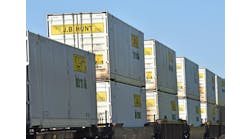Logistics professionals face a “Grand Challenge.” Some are contemplating how to deal with it, but their efforts haven’t gone much beyond contemplation. However, the convergence of environmental and economic requirements in their supply chains seems to be reaching a tipping point that will bring the “Grand Challenge” down to earth.
What is this challenge? Recently a logistics researcher named B. Montreuil wrote a paper summarizing it in one sentence:
“To enable the global sustainability of physical object mobility, storage, realization, supply and usage.”
Basically, it’s the ability to move anything anywhere it’s needed in the most efficient way possible. The Internet has enabled us to do that with information, now it’s time to do it with the stuff that information’s about. However, Montreuil concluded that this goal is not achievable with our current logistics system—a system that, according to government statistics, uses less than half of its transportation capacity. He proposed a new model to answer the grand challenge. It’s called “The Physical Internet.”
The PI is envisioned as an open global logistics system based on physical, digital and operational interconnectivity through standardized packaging, interfaces and protocols. Russ Meller, who has taken up the challenge to better define this concept and make it real, says, “Imagine an eBay-like exchange with all freight specified based on smart, modular containers, and visible to a vast community of users that rate each other to drive performance.” Meller is a professor in the department of industrial engineering at the University of Arkansas and director of CELDi, a university-based enterprise providing innovative solutions for logistics and distribution excellence with its member organizations. The National Science Foundation provides funding for the administration of CELDi to bring industry and universities together.
Meller, who is also a member of MH&L’s editorial advisory board, wants to expose the PI model to an even broader population of academics and logisticians so they can both buy into it and help develop it.
“The greatest opportunity for future research comes from examining the potential to collaborate in the distribution of goods in a logistics system utilizing modular containers,” he writes in the first draft of his research paper, co-authored with Kimberly Ellis, from the Grado Department of Industrial and Systems Engineering at Virginia Tech. “Load planning models that illustrate the benefits of the PI, enabled by modular containers, are needed to calculate the value of such collaboration.”
So, just as the digital Internet transmits data in standardized packets via a global information network at great speed, the physical Internet will transmit products in standardized packages via a global transportation network with great efficiency. But it will take a lot of buy-in to make it real.
Better Network Utilization
Some of what Meller talks about is already happening in bits and pieces among shippers, customers and third parties within different industries.
For example, Chemlogix, a 3PL that serves chemical manufacturers, touts the value of using 3PLs to broadcast available backhaul opportunities to improve transportation capacity. Using this service, shippers identify and add volume to an existing carrier’s complementary or empty return lanes. Load matching carrier’s or other shipper’s lanes in the opposite or complementary direction adds capacity to our transportation infrastructure—which Meller says is sorely needed.
“For all the incredible things the logistics industry has done, it’s not structurally very different from how it was 30 years ago,” he says. “Given we’re stuck in a system that has less than 50% utilization, it will take something different than a new transportation management system (TMS). That’s why we want everyone to get into the innovation space to make this happen.”
The closest equivalents Meller can identify that exist in the real world are services like Kane is Able, a Scranton, Pa.-based third-party logistics provider, and Tri-Vizor, a Belgium-based cross-supply-chain “orchestrator.” Kane is Able pools the inventory and shipments of middle-market CPG manufacturers so the same volume of goods is delivered to retailers using fewer trucks. Tri-Vizor creates and manages horizontal communities of shippers and logistic service providers “with the primary objective of maximizing total gains for the community,” its website states. The service also addresses legal issues involving anti-trust among potential competitive shippers.
Sounds like this covers all the bases—except the Internet part. TriVizor uses a database that they proactively mine to find logical partners and then they approach these parties about making their relationship happen. Meller says this model doesn’t approach the scale envisioned for the Physical Internet.
Sven Verstrepen, one of the TriVizor founders, told Meller the service could link four or five partners at a time. Meller is thinking more along the lines of four or five thousand.
“The kind of collaboration people employ today does not scale,” Meller says. “And to scale, you need a common language. The language of logistics is packaging, business rules, protocols, operating policies, etc.”
At one of Meller’s recent PI project meeting, two shippers who are already part of a collaborative logistics arrangement made possible through their 3PL service providers, talked about the benefits of their collaborative arrangements. However, these shippers had to ask for the service from their 3PLs—and it required commitments, which can create barriers. One of the shippers told Meller, “I want to date everyone to maximize my enjoyment, not get married. Today, you have to get married in the shipping world.”
Better Asset Utilization
Up to this point we’ve focused on the flow component of the physical Internet, but that component can’t be realized until the world addresses the physical aspects of what is flowing. There’s still a lot to fix on that side, particularly the unused capacity.
Meller cites government statistics showing 25% of the trucks on the road are completely empty. And of the 75% that are full, they’re only 56.8% full. That means trailers are only 43.2% utilized.
“With fully utilized truck loads, we would reduce the number of miles driven by 83.2 billion, which would be 16.5 billion gallons of diesel fuel, which is $65.8 billion,” he says. “On the sustainability side, if you filled trailers, the CO2 emissions you’d get rid of would represent half of Canada or Mexico’s entire output of CO2 emissions. This could make a huge economic and environmental impact.”
Better utilization requires a better packaging standardization scheme, and by better, Meller means fewer size variations. He related that they were initially concerned that fewer size variations would actually lead to move volume shipped—which would defeat the goals of the physical Internet.
“However, our study with one of the largest CPG companies in the U.S. showed that reducing packaging choices down from 258 did hurt a little on the utilization of the case, but these were modular cases that fully utilized the pallet, so the net shipping volume increase was zero. And it would benefit the supply chain as a whole from a collaboration standpoint,” he says. “When you start to get modular you can specify a load better, therefore transportation service providers can figure out whether to accept it or not.”
Inter-Industry Cooperation
For packaging utilization and trailer utilization to meet in the physical internet model, carriers will have to abandon market segmentation, Meller says. He uses Florida as an example of what has so far been a missed opportunity for carriers.
“Florida is a notoriously difficult freight state because there’s so much going in and so little coming out, and what’s coming out is produce,” he says. “Why is anybody running a non refrigerated trailer into Florida with freight? They should be running refrigerated trailers even if they’re carrying nothing that needs refrigeration on the way in because it vastly increases their chance of getting a backhaul.”
Ideally the physical internet will reduce costs, reduce empty miles—and therefore shrink everyone’s carbon footprint. It would give carriers better access to loads—especially independent carriers—and fewer total miles would be driven.
The challenges aren’t as daunting on the technology side as they are on the physical side, according to Jim LeTart, corporate marketing manager for RedPrairie, a transportation management system vendor.
“It’s not that big a shift for the transportation software side, because the way we look at it it’s very similar to what we do now with pool points,” he says. “The main difference is it’s not a single shipper, it’s multiple shippers and it goes to some of the initiatives that have gone on with trying to do round trip sharing. It comes down to keeping trucks full all the time.”
The harder part is how participants share pricing and cost information. If you’re a shipper sharing the same truck with other shippers—possibly a competitor—how can this model determine what rates to charge?
“You won’t use rate tables like you do today, which are negotiated on a bid basis, it will be more of a standardized rate, but how do you allocate that?,” LeTart asks.
Other considerations:
➤ How will carriers feel about becoming commodities?
➤ How will service standards be developed—by some master board or association rather than individual carriers?
LeTart believes Meller is onto something, but the development of the Physical Internet will be a long-term process.
“There are big companies interested, so that tells me this has a shot,” he concludes. “But it took bar codes 30 years to be accepted and I think you’ll see that kind of long-term development for this.”
Meller doesn’t believe the market will wait that long—especially Europe, if it renews its focus on sustainability goals.
As he heads into the last six months of this two-year PI project, he and Ellis will start to develop the business case. The first 18 months have been devoted to strategizing on packaging and load planning, but none of that will matter unless all nodes in a global network are in sync.
Meller and Ellis have strong allies to help them through the second phase. That help includes funding from the U.S. National Science Foundation as well as thought leadership from a wide variety of organizations. These include companies from the consumer products supply chain, transportation services providers and industry organizations such as the American Transportation Research Institute and the Material Handling Industry of America.
Meller also invites anyone reading this article to learn more about the project and take part (faculty.ineg.uark.edu/rmeller/web/CELDi-PI/index-PI.html). This support will make the Physical Internet project a more prominent agenda item for key decision makers in government and global commerce.



